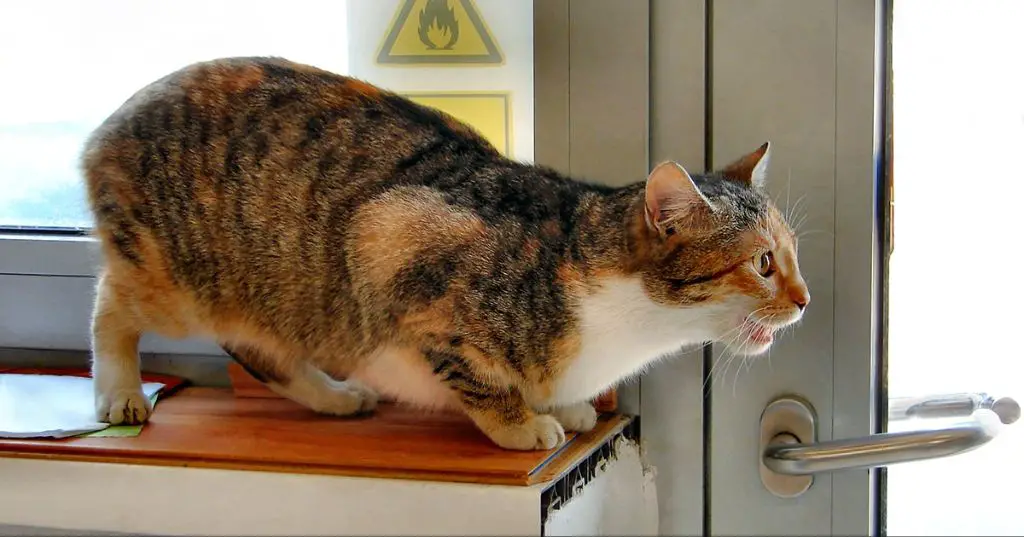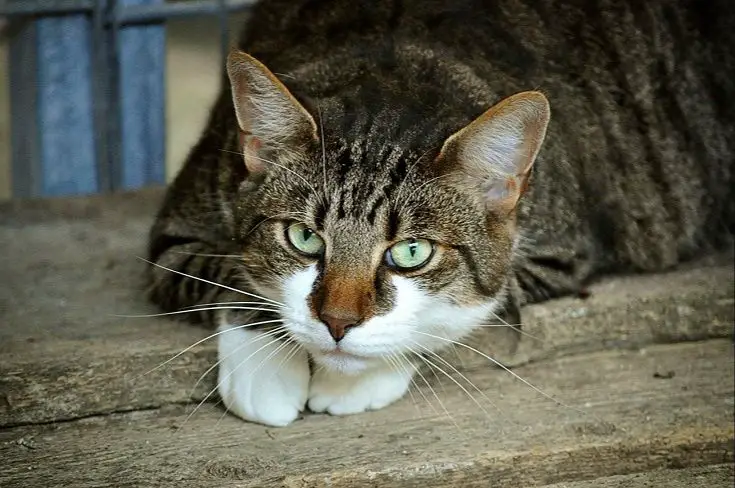What Does It Mean When a Cat is in Heat?
When a cat is in heat, it means she has entered her fertile period and is ready to mate. This fertile time is known as a cat’s estrus or estrous cycle, which is the feline equivalent of a menstrual cycle in humans. However, unlike the menstrual cycle which occurs monthly, cats only go into heat seasonally, usually in the spring and summer.
A cat’s heat period is triggered by increasing daylight hours, which causes changes in her hormones. When in heat, female cats become very vocal and behaves differently – she may roll around, rub against objects, raise her rear into the air, and tread her hind legs. This is the cat’s way of signaling to male cats that she is ready to mate. Her heat cycle will last about 4-6 days on average [1], but can last anywhere from 1-3 weeks. During this time, she will be driven to find a mate and breed. If the cat does not successfully breed during her heat, she will go out of heat for a short period of time before cycling back into heat again.
How Often Do Cat Heat Cycles Occur?
Cats typically go into heat multiple times each year during breeding season. According to VCA Animal Hospitals, “Cats are seasonally polyestrous, which means that they have multiple cycles during the breeding season.” The breeding season for cats generally runs from spring through fall in most climates.
During this breeding season, female cats will go into heat as frequently as every 2-3 weeks. Each heat cycle can last anywhere from 5-10 days on average. Cats do not ovulate until the very end of their heat cycle. If they are not bred during that short 12-24 hour ovulation window, their heat will end and the cycle will repeat again in 2-3 weeks.
According to Bond Vet, “Once estrous cycles begin, cats may go into heat as often as every 2-3 weeks.” While the frequency can vary from cat to cat, most will have multiple heat cycles lasting 5-10 days during each breeding season, repeating every couple of weeks until the season ends in late fall.

What Age Do Female Cats Go Into Heat?
Most female cats experience their first heat cycle between 6-9 months of age, though it can vary from as early as 4 months to as late as 12 months.[1] The specific age depends on factors like the cat’s breed, health, and time of year.
Siamese cats, for example, tend to go into heat earlier than other breeds, starting their first cycle as early as 4 months old. Overweight and obese cats may experience delayed sexual maturity and enter heat later than average. Cats born in the later summer or fall months often have their first heat cycle sooner than cats born in the winter or spring.
In general, a healthy female cat can get pregnant during her first heat, which lasts about 4-7 days. It’s important to watch for signs of heat cycles starting in unspayed cats around 6 months old to either prevent breeding or consider getting them spayed if kittens are not desired.
[1] https://bondvet.com/b/when-do-cats-go-into-heat
Behaviors to Expect When a Cat is in Heat

There are some clear behavioral changes to expect when a cat goes into heat. One of the most noticeable signs is increased vocalizing. According to https://vetic.in, cats in heat tend to meow, yowl and make loud noises more often to attract potential mates.
Cats in heat also become more affectionate and rub up against objects more. As explained by https://revealpetfood.com, this rubbing behavior deposits pheromones from glands around their tail to mark territory and advertise reproductive status.
There are also posture changes to expect when a cat is in heat. The most noticeable sign is raising their hindquarters up in the air while keeping their front end low to the ground. This lordosis posture signals receptiveness to mating for male cats.
How to Deal With a Cat in Heat
A cat in heat exhibits behaviors like loud yowling and restless energy that can be disruptive in the home. Here are some tips to help deal with these behaviors:
Provide plenty of outlets for their energy like toys they can chase and pounce on. Consider getting toys like feather wands and laser pointers that allow interactive play while keeping a safe distance from an agitated cat. Rotate high-energy playtime with quiet toys like treat balls and tunnels they can enjoy alone.

Give them access to perches up high they can observe their surroundings from which can satisfy their restless instinct to patrol for mates. Place climbing structures and cat trees by windows.
Use pheromone diffusers like Feliway to help calm them during this stressful time. Pheromones can reduce anxious behaviors.
Keep litter boxes extremely clean, as cats can be particular about this during a heat. Clean at least 1-2 times daily.
Ignore yowling behaviors rather than punishing or rewarding them, as this can reinforce the vocalizing. Instead, initiate playtime or offer treats when she is quiet to encourage calmness.
Provide a safe confined area she can stay in with food, water, litter and comforting items. This reduces roaming and allows her to rest removed from other animals.
Talk to your vet about anti-anxiety medication if heat behaviors don’t improve with natural methods. Medication can temporarily help minimize distress.
Dangers of Letting a Cat Breed While in Heat
There are some significant dangers associated with allowing a cat to breed while in heat. One major concern is health risks posed by early pregnancy. Kittens born to young cats may have higher mortality rates. Cats under 1 year old are still growing and may struggle to nourish a litter properly. Pregnancy complications like dystocia and pyometra are also more common in young, first-time mothers (Holst, 2022).
Letting cats breed freely also contributes to pet overpopulation. Millions of unwanted cats enter shelters each year, and many healthy animals are euthanized due to lack of space and adopters. Spaying cats is the most effective way to combat overpopulation and reduce shelter intake. It’s best for owners to have cats fixed before their first heat unless intentionally breeding purebred cats responsibly.
Reducing Heat Cycles With Spaying
Spaying refers to the surgical sterilization procedure performed on female cats, involving removal of the ovaries and uterus. This eliminates the cat’s ability to go into heat and get pregnant. It’s typically done around 6 months of age before the first heat cycle begins.
Spaying provides many health and behavioral benefits for female cats according to the ASPCA[1]. It eliminates the risk of uterine and ovarian cancers later in life which are common in intact cats. Spaying also reduces the chances of mammary tumors. From a behavioral standpoint, spayed cats are less likely to urine mark, exhibit mating behaviors, or try to escape the home in search of mates.
Overall, spaying is recommended by most vets and shelters as an important way to control cat overpopulation and provide health/behavioral benefits for the individual cat. While a major surgery, the procedure is routine and generally low risk when performed by an experienced vet on a healthy cat.
Using Supplements to Postpone or Suppress Heats
Some pet owners seek to postpone or suppress their cat’s heat cycles through the use of medications like progestins. One common medication used for this purpose is megestrol acetate (MA). Megestrol acetate is a synthetic progestin that can temporarily prevent cats from going into heat.
According to VCA Animal Hospitals, megestrol acetate works by suppressing the release of hormones that trigger estrus. It does not sterilize cats or permanently stop cycles from occurring. The effects of MA wear off over time, and cats will eventually go back into heat after stopping treatment.

While MA can postpone heats, pet owners should be aware of potential side effects. Megestrol acetate may lead to diabetes, mammary tumors, uterine infections, and cystic endometrial hyperplasia in cats. It also requires careful dosing and ongoing veterinary monitoring. Pet owners should consult their vet before starting MA treatment.
There are also some concerns about the safety of long-term or high-dose MA use. The Maddie’s Fund recommends MA only be used for limited periods of time and under a vet’s supervision. Pet owners should work closely with their vet to minimize risks if considering MA for their cat.
Providing a Safe, Comfortable Environment
One of the best things you can do for a cat in heat is to keep her safely indoors. This prevents exposure to roaming male cats who may try to mate with her. Keep doors and windows closed and make sure there are no small openings where males could get in.
You can also use synthetic feline pheromones like Feliway to help calm your cat. As explained on Feliway.com, these pheromones mimic cats’ natural facial pheromones and create a feeling of comfort and security. Diffuse the Feliway around your home to reduce anxiety and restlessness in a cat in heat.
Make sure your cat has access to her normal amenities like food, water, litter box, scratching posts, toys, and comfy bedding. Try placing these resources in quiet, low-traffic areas of your home to further reduce stress.
You can also give your cat extra playtime and affection to distract her from the heat cycle. Just be patient, as she may be more irritable or restless than usual.
When to See the Vet for a Cat in Heat
If your cat’s heat cycles last longer than normal, it’s a good idea to take her to the vet. Typically, feline heat cycles last about 1-2 weeks. However, some cats may experience abnormally prolonged heats lasting 3-4 weeks or more. According to VCA Hospitals, heat cycles lasting longer than 3 weeks can indicate an underlying health issue that requires veterinary attention.
Some conditions that can cause excessive heat cycles in cats include:
- Ovarian cysts
- Hormone imbalances
- Uterine infections
If your vet determines that your cat’s heat cycles are excessively long, they may recommend spaying to control her hormones and prevent complications. This is why it’s important to monitor the length of your cat’s heats and notify your vet if any seem abnormally prolonged.
You should also consult your vet if you’re considering spaying your cat. Spaying, or neutering, is the surgical removal of the ovaries and uterus. Most veterinarians recommend spaying prior to your cat’s first heat cycle, which is around 6 months of age. Spaying provides major health benefits by eliminating heat cycles and preventing certain cancers. Your vet can advise you on the ideal timing for this routine surgery.

